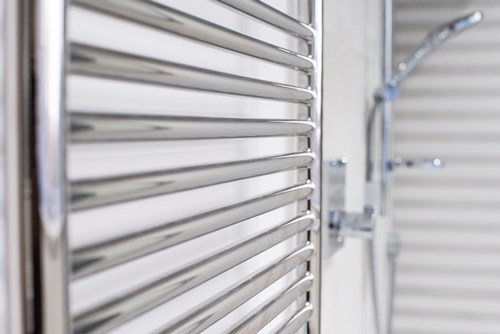When designing a bathroom sometimes it is easy to get caught up in the aesthetics and products. What heating is needed can sometimes be an afterthought. However, the heating of your bathroom is as crucial as the power of your shower! The bathroom has a special set of heating requirements that need to be considered. You must know exactly how much heat you need and find the best way to do this within your chosen design. Deciding on the right heating is an area that a bathroom designer can really add value. So, what do you need to consider?
Make sure you know the BTU of your bathroom
This is something you may not have heard of but when looking at what heating you need you must consider the size and shape of the room. BTU stands for British Thermal Unit and is an approximation of the amount of energy required to heat 1lb of water from 39 degrees Fahrenheit to 40 degrees Fahrenheit. A room’s BTU requirement is based on the cubic volume of the space, which is the height, length and width of the room multiplied by 4. By doing these calculations you can work out the expected heat loss and discover the BTU output you require to heat a room effectively. It is vital to do this before planning your bathroom heating. Not knowing this information could lead you to install a radiator that never reaches its optimum temperature or providing too high a heat which could result in larger household bills.
What are the advantages of underfloor heating?
Underfloor heating is now very popular in bathrooms and it is easy to see why. Not only is it nice to have a warmth underfoot, especially on cold winter mornings, it is also a very efficient way of heating a bathroom. Underfloor heating gently heats a room, evenly distributing warmth around the whole space. It usually heats a room quicker as it heats the floor not the air as radiators do. This warmth from the ground up is less wasteful, as warmth circulates, meaning there are no cold spots. Underfloor heating is great for small bathrooms as it doesn’t take up any space and once installed requires little maintenance. As it doesn’t overheat it is also a great child friendly option. Any bathroom could benefit from this type of heating.
What about heated towel rails and radiators?
Heated towel rails are a great way to maximise space in a bathroom as they create heat whilst at the same time drying out towels. Many of the great brands we use create stylish radiators that look good in our finished bathrooms. Most towels rails provide enough warmth to heat a room, however if you have a large space a towel rail may not be enough, and another radiator may be required. Again, knowing the BTU of your bathroom will ensure you get the right heating products for the space.
It is also worth considering isolating your heated towel rail from your central heating as in Summer you will still want to use this function, without turning your whole central heating system on. The cost to do this is around £200. This covers the additional electrical work that is required. Most of our clients choose this option as it cannot be retro fitted after the bathroom is completed.
What flooring should I choose?
We often find that tiles are preferable to laminate for bathroom flooring as they are waterproof, stylish and cost effective. You can now get some great designs that can really compliment your bathroom style. Laminate flooring is not truly waterproof, and we would normally advise against carpet as it retains moisture. Tiles are easy to clean, hardwearing and hygienic. Often people worry that tiles make you feel cold but paired with underfloor heating they are a stylish and practical solution for your bathroom.



